

Giuseppi Logan and the Light. Not since January of this year have I had time to write here at No Sound Left Behind.
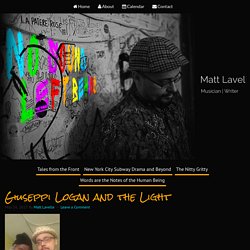
I devoted every second to getting better at music and writing. At Rutgers, I engaged in an independent study with Dr. Henry Martin to transcribe 6 Duke Ellington small band sides. New theory may explain the ‘music of the meteors’ For centuries, some observers have claimed that shooting stars or meteors hiss as they arc through the night sky.
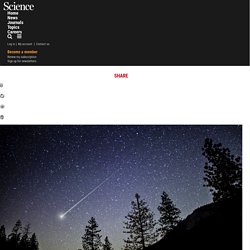
And for just as long, skeptics have scoffed on the grounds that sound waves coming from meteors should arrive several minutes after the light waves, which travel nearly a million times faster. Now, scientists have proposed a theory to explain how our eyes and ears could perceive a meteor at nearly the same time. The hypothesis might also explain how auroras produce sound, a claim made by many indigenous peoples living at high latitudes. Meteors release huge amounts of energy as they disintegrate in the atmosphere. They also produce low frequency radio waves that travel at the speed of light. But nailing down that scenario isn’t easy. Now, Price and Michael Kelley, a physicist at Cornell University, have developed a model to answer that question. Why tapes matter – The Hum Blog. I’m pretty obsessed with contemporary cassette culture.
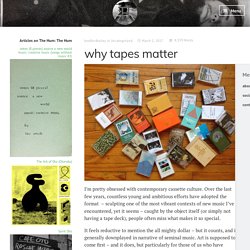
Over the last few years, countless young and ambitious efforts have adopted the format – sculpting one of the most vibrant contexts of new music I’ve encountered, yet it seems – caught by the object itself (or simply not having a tape deck), people often miss what makes it so special. Plug (Luke Vibert) - Maker Of All. Novachord Restoration Project. The "brain" of the instrument The massive "Generator" consists of the control box in the front, and channels 1 through 9 in the rear.
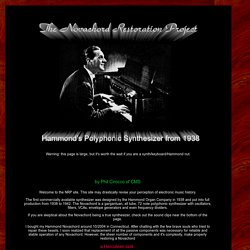
All the audio processing in the Novachord is performed in the generator. The Control Box houses the controls for the instrument as well as all the passive audio processing circuits including the 5 resonators. Channels 1 - 9 house the active vacuum tube circuits. There are 12 oscillators, 60 frequency dividers, 60 band pass filters, 72 VCA's, a pre amp and a hex-vibrati in the generator. Brandford Marsalis on Jerry Garcia & Grateful Dead - Lost Interview 1996.
The A=432 Hz Frequency: DNA Tuning and the Bastardization of Music. Brendan D.

Murphy, Guest GA=440Hz: Not Quite Music to My Ears. John Coltrane's Handwritten Outline for His Masterpiece A Love Supreme. Click the image above to view it in a larger format.

The great jazz saxophone player John Coltrane was born 87 years ago today. To mark the occasion we present this rare document from the Smithsonian’s National Museum of American History: Coltrane’s handwritten outline of his groundbreaking jazz composition A Love Supreme. Recorded in December of 1964 and released in 1965, A Love Supreme is Coltrane’s personal declaration of his faith in God and his awareness of being on a spiritual path. György ligeti’s artikulation (with score and audio) – The Hum Blog. Score for György Ligeti’s Artikulation Following the inexplicable success of my piece focusing on Cornelius Cardew’s Treatise, I thought it might be nice to shine the light on another seminal work from the cannon of avant-garde gestures within Twentieth Century Classical Music – György Ligeti’s Artikulation.

Ligeti will be familiar to most. With Iannis Xenakis, Pierre Boulez, Luciano Berio, and Karlheinz Stockhausen, he is one of the most most noted European composers of the Post-War period. The A=432 Hz Frequency: DNA Tuning and the Bastardization of Music. Speaking in tongues, a documentary on milford graves from 1982 featuring david murray (in three parts) – The Hum Blog. Made at the tail end of an era which saw profound expressions of African American self-actualization, nationalism, political optimism, and social realism, Speaking in Tongues is an important document.
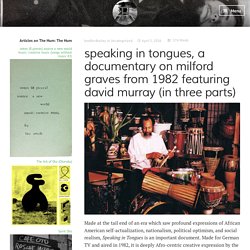
Made for German TV and aired in 1982, it is deeply Afro-centric creative expression by the filmmaker Doug Harris, using the remarkable Free-Jazz drummer Milford Graves as a vehicle to discuss the expanded Black consciousness and spirituality which grew from the gestures of Albert Ayler. Graves has always been one of my favorite drummers, composers, and improvisors. The Tragedy of A Relationship. In August 2000, Ravi Shankar’s first wife, the reclusive surbahar virtuoso Annapurna Devi, did her only interview in 60 years with me in which she spoke about her torturous marriage and the tragic life of their son Shubho.
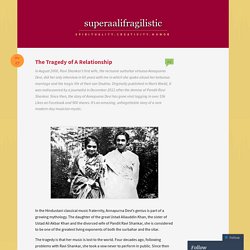
Originally published in Man’s World, it was rediscovered by a journalist in December 2012 after the demise of Pandit Ravi Shankar. Since then, the story of Annapurna Devi has gone viral logging in over 10k Likes on Facebook and 900 shares. A collection of photos of la monte young & co – The Hum Blog. I’m a big La Monte Young fan.
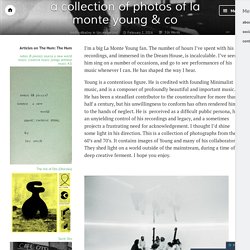
Tibetan buddhist tantric scores – The Hum Blog. I’ve been a devotee of Tibetan Buddhist Tantric music for years. I love it so much, that I impulsively buy it on faith whenever I come across a record that I know I don’t have. My collection of it is pretty expansive at this point. I’ve lost track, but I must have somewhere between 50 and 75 LPs stretching across its traditions.
It’s an incredible, deeply spiritual, and complex music. A collection of photos of la monte young & co – The Hum Blog. Photo album for the 1960’s & 70’s american avant-garde – The Hum Blog. Everyone has seemed to love the photo albums I posted on La Monte Young and Joan La Barbara, so I thought I’d round it out, and broaden my subject to the breadth of avant-garde music from the 1960’s and 70’s. This is one of my favorite periods of music. These are images that I’ve collected while wanderings around the internet. I’ve done my best to cover as broad a range as seemed reasonable (roughly 60 images), but I haven’t managed to be as inclusive as I might have liked. Let’s chock it up to taste for now, as those represented are among my favorites of the generation. I hope you enjoy, and that they give you a window into an incredibly exciting period of thought, experiment, and sound. New Ways Into the Brain’s ‘Music Room’ The new paper “takes a very innovative approach and is of great importance,” said Josef Rauschecker, director of the Laboratory of Integrative Neuroscience and Cognition at Georgetown University.
“The idea that the brain gives specialized treatment to music recognition, that it regards music as fundamental a category as speech, is very exciting to me.” In fact, Dr. Rauschecker said, music sensitivity may be more fundamental to the human brain than is speech perception. “There are theories that music is older than speech or language,” he said. “Some even argue that speech evolved from music.” And though the survival value that music held for our ancestors may not be as immediately obvious as the power to recognize words, Dr. Vijay Iyer, the Harvard Professor Changing Jazz.
Vijay Iyer’s music can be jubilant and dramatic, but Iyer is not. He tends to stand slightly farther from someone he is speaking with than people usually do. Seated, he sometimes leans back from an engagement, as if the extra room allowed him more time to reach a judgment. His gaze is examining, and he occasionally looks at people askance, which makes him appear skeptical. In conversation, he seems cautious but precise and quietly determined. Inside Abbey Road. David Bowie. David Bowie is not simply the prettiest star—he’s a constellation.
No matter which Bowie you first encountered—the orange-haired alien androgyne of Ziggy Stardust, the creepy clown in the “Ashes to Ashes” video, the louche lothario of the Let’s Dance era, or even the guy refereeing Derek Zoolander’s walk-offs—you were instantly disarmed by his style, sophistication, and presence. But Bowie was the rare rock legend whose mythology is defined more by his intellectual curiosities than his cocaine-fuelled debauchery. The famous parade of personae that defined his astounding 1970s discography represented not just new sounds and aesthetics; Bowie was essentially a human Internet, with each album serving as a hyperlink into a vast network of underground music, avant-garde art, art-house film, and left-field literature. Kurt Schwitters - Ursonate. Reverse Engineering: Danny Hyde On Coil, Backwards & NIN. Composer_ivan_wyschnegradsky_s_color_wheels_representing_his_microtonal.
Russian composer Ivan Wyschnegradsky was a 20th-century avant-garde pianist devoted to “creating a work capable of awakening in every man the slumbering forces of cosmic consciousness,” according to his journal. To achieve this mystical ideal, he set out to create sounds that no one had ever heard before. His music was microtonal, a style that transcends the limitations of the 12-scale tuning system in traditional Western music.
Microtones are essentially notes between notes—like the incremental dashes between the 12-inch markings on a ruler. Because standard pianos cannot play this kind of music, Wyschnegradsky moved to Paris in 1923 to start building a new one. Naturjuuz.